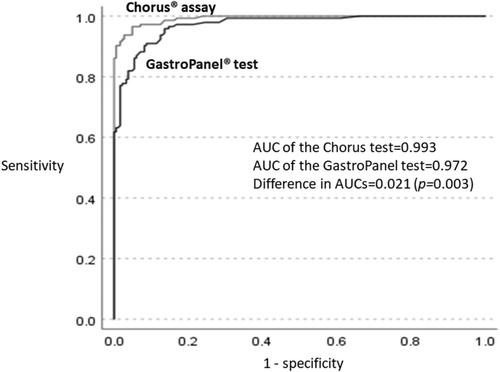Comparison between the GastroPanel test and the serum pepsinogen assay interpreted with the ABC method—A prospective study
Abstract
Background and Aims
This study aimed to validate Helicobacter pylori serological and pepsinogen (PG) assays for detecting infection and gastric neoplasm.
Methods
Individuals who underwent serum Chorus H. pylori and HBI PG assays were included from May to September 2023. The GastroPanel test was performed using the same blood sample. HBI assay findings were interpreted with the ABC method using the criteria of corpus atrophy (PG I ≤ 70 ng/mL & I/II ≤3) and advanced corpus atrophy (PG I ≤ 30 ng/mL & I/II ≤2).
Results
A total of 144 H. pylori-infected and 184 non-infected Koreans were analyzed. The Chorus test (sensitivity 97.2%, specificity 89.1%) showed higher area under the curve (0.993 vs. 0.972, p = 0.003) than the GastroPanel test (sensitivity 95.8%, specificity 86.4%). Using the GastroSoft application, the incidence of gastric neoplasms was highest in the corpus atrophy group (50%), followed by the low acid-output (25.8%), H. pylori infection (11.6%), and antral atrophy (9.1%) groups. There were no gastric neoplasms in the normal and high acid output groups. Using the ABC method, the incidence of gastric neoplasms was highest in the corpus atrophy groups (23.8% in Groups C and D), followed by Group B (12.3%) and Group A (2.4%). Corpus atrophy interpreted with the GastroSoft showed poor agreement (k = 0.225) with corpus atrophy interpreted with the ABC method, whereas it showed excellent agreement (k = 0.854) with advanced corpus atrophy.
Conclusions
Although the Chorus test was more accurate than the GastroPanel test, both assays discriminated high-risk individuals by detecting atrophy or infection. There were no gastric neoplasms in the normal or high acid-output groups (GastroSoft application), and gastric neoplasm incidence was lowest in Group A (ABC method). Corpus atrophy determined by GastroSoft application is more consistent with advanced corpus atrophy determined by the ABC method than is corpus atrophy.


 求助内容:
求助内容: 应助结果提醒方式:
应助结果提醒方式:


